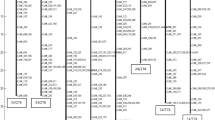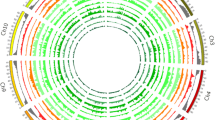Abstract
A low level of genetic variation has limited the application of molecular markers for characterizing important traits in cultivated tomato. To detect polymorphisms in tomato conserved ortholog sets (COS), expressed sequence tags (ESTs) were searched against tomato and Arabidopsis genomic sequences to define the positions of introns. Introns were amplified from 12 different accessions of tomato by polymerase chain reaction and nucleotide sequences were determined by sequencing. Results indicated that there was a possibility of 71% to amplify introns from tomato genomic DNA through this approach. A total of 201 introns were sequenced from 86 COS unigenes. The intron positions and numbers were conserved between tomato and Arabidopsis, but average intron length was three times longer in tomato than in Arabidopsis. A total of 307 single nucleotide polymorphisms (SNPs) and 75 indels were detected in introns of 57 COS unigenes among 12 tomato lines. Within cultivated tomato germplasm 172 SNPs and 47 indels were detected in introns of 33 COS unigenes. In addition, 41 SNPs were identified in the exons of 27 COS unigenes. The frequency of SNPs was 2.4 times higher in introns than in exons in the 22 COS unigenes having both intronic and exonic polymorphisms. These results indicate that intronic regions may contain sufficient variation to develop sufficient marker resources for genome-wide analysis in cultivated tomato.


Similar content being viewed by others
References
Archak S, Karihaloo JL, Jain A (2002) RAPD markers reveal narrowing genetic base of Indian tomato cultivars. Curr Sci 82:1139–1143
Bernatzky R, Tanksley SD (1986) Toward a saturated linkage map in tomato based on isozymes and random cDNA sequences. Genetics 112:887–898
Bierne N, Lehnert SA, Bédier E, Bonhomme F, Moore SS (2000) Screening for intron-length polymorphism in penaeid shrimps using exon-primed intron-crossing (EPIC)-PCR. Mol Ecol 9:233–235
Chen J, Shen HL, Yang WC (2007) Development of tomato molecular markers. Mol Plant Breed 5(6S):130–138
Chen J, Wang H, Shen HL, Chai M, Li JS, Qi MF, Yang WC (2009) Genetic variation in tomato populations from four breeding programs revealed by single nucleotide polymorphism and simple sequence repeat markers. Sci Hortic 122:6–16
Daguin C, Borsa P (1999) Genetic characterization of Mytilus galloprovincialis Lmk. in North West Africa using nuclear DNA markers. J Exp Mar Biol Ecol 235:55–65
Foolad MR (2007) Genome mapping and molecular breeding of tomato. Int J Plant Genomics. doi:10.1155/2007/64358
Fulton TM, Van der Hoeven R, Eannetta NT, Tanksley SD (2002) Identification, analysis, and utilization of conserved ortholog set markers for comparative genomics in higher plants. Plant Cell 14:1457–1467
Garcia-Martinez S, Andreani L, Garcia-Gusano M, Geuna F, Ruiz JJ (2005) Evolution of amplified length polymorphism and simple sequence repeats for tomato germplasm fingerprinting: utility for grouping closely related traditional cultivars. Genome 49:648–656
Hassan M, Lemaire C, Fauvelot C, Bonhomme F (2003) Seventeen New EPIC-PCR amplifiable introns in fish. Mol Ecol 2:334–340
Jiménez-Gómez JM, Maloof JN (2009) Sequence diversity in three tomato species: SNPs, markers, and molecular evolution. BMC Plant Biol 9:85
Kabelka E, Franchino B, Francis DM (2002) Two loci from Lycopersicon hirsutum LA407 confer resistance to strains of Clavibacter michiganensis subsp. michiganensis. Phytopathology 92:504–510
Labate JA, Baldo AM (2005) Tomato SNP discovery by EST mining and resequencing. Mol Breed 16:343–349
Labate JA, Robertson LD, Baldo AM (2009) Multilocus sequence data reveal extensive departures from equilibrium in domesticated tomato (Solanum lycopersicum L.). Heredity 103:257–267
Lessa EP (1992) Rapid survey of DNA sequence variation in natural populations. Mol Biol Evol 9:323–330
Miller JC, Tanksley SD (1990) RFLP analysis of phylogenetic relationships and genetic variation in the genus Lycopersicon. Theor Appl Genet 80:437–448
Mueller LA, Lankhorst RK, Tanksley SD et al (2009) A snapshot of the emerging tomato genome sequence. Plant Genome 2:78–92
Nei M (1987) Molecular evolutionary genetics. Columbia University Press, New York
Nei M, Li WH (1979) Mathematical model for studying genetic variation in terms of restriction endonucleases. Proc Natl Acad Sci USA 76:5269–5273
Nesbitt TC, Tanksley SD (2002) Comparative sequencing in the genus Lycopersicon: implications for the evolution of fruit size in the domestication of cultivated tomatoes. Genetics 162:365–379
Park YH, West MAL, St. Clair DA (2004) Evaluation of AFLPs for germplasm fingerprinting and assessment of genetic diversity in cultivars of tomato (Lycopersicon esculentum L.). Genome 47:510–518
Rick CM, Fobes JF (1974) Association of an allozyme with nematode resistance. Rpt Tomato Genet Coop 24:25
Rozas J, Rozas R (1999) DnaSP version 3: an integrated program for molecular population genetics and molecular evolution analysis. Bioinformatics 15:174–175
Rozen S, Skaletsky H (2000) Primer3 on the WWW for general users and for biologist programmers. Methods Mol Biol 132:365–386
Scott JW, Harbaugh BK (1989) Micro-Tom—a miniature dwarf tomato, Circular S-370, Florida Agricultural Experiment Station, pp 1–6
Scott JW, Francis DM, Miller SA, Somodi GC, Jones JB (2003) Tomato bacterial spot resistance derived from PI 114490; inheritance to race T2 and relationship across three pathogen races. J Am Soc Hortic Sci 128:698–703
Sim SC, Robbins MD, Chilcott C, Zhu T, Francis DM (2009) Oligonucleotide array discovery of polymorphisms in cultivated tomato (Solanum lycopersicum L.) reveals patterns of SNP variation associated with breeding. BMC Genomics 10:466
Tajima F (1993) Statistical analysis of DNA polymorphism. Jpn J Genet 68:567–595
Tam SM, Mhiri C, Vogelaar A, Kerkveld M, Pearce SR, Grandbastien MA (2005) Comparative analyses of genetic diversities within tomato and pepper collections detected by retrotransposon-based SSAP, AFLP and SSR. Theor Appl Genet 110:819–831
Temesgen B, Brown GR, Harry DE, Kinlaw CS, Sewell MM, Neale DB (2001) Genetic mapping of expressed sequence tag polymorphism (ESTP) markers in loblolly pine (Pinus taeda L.). Theor Appl Genet 102:664–675
Van der Hoeven R, Ronning C, Giovannoni J, Martin G, Tanksley S (2002) Deductions about the number, organization, and evolution of genes in the tomato genome based on analysis of a large expressed sequence tag collection and selective genomic sequencing. Plant Cell 14:1441–1456
Van Deynze A, Stoffel K, Buell CR, Kozik A, Liu J, van der Knapp E, Francis D (2007) Diversity in conserved genes in tomato. BMC Genomics 8:465
Watterson GA (1975) On the number of segregating sites in geneticalmodels without recombination. Theor Popul Biol 7:256–276
Wei H, Fu Y, Arora R (2005) Intron-flanking EST–PCR markers: from genetic marker development to gene structure analysis in Rhododendron. Theor Appl Genet 111:1347–1356
Williams CE, St Clair DA (1993) Phenetic relationships and levels of variability detected by restriction fragment length polymorphism and random amplified polymorphic DNA analysis of cultivated and wild accessions of Lycopersicon esculentum. Genome 36:619–630
Wu F, Mueller LA, Crouzillat D, Petiard V, Tanksley SD (2006) Combining bioinformatics and phylogenetics to identify large sets of single copy, orthologous genes (COSII) for comparative, evolutionary and systematics studies: a test case in the Euasterid plant clade. Genetics 174:1407–1420
Yamamoto N, Tsugane T, Watanabe M, Yano K, Maeda F, Kuwata C, Torki M, Ban Y, Nishimura S, Shibata D (2005) Expressed sequence tags from the laboratory-grown miniature tomato (Lycopersicon esculentum) cultivar Micro-Tom and mining for single nucleotide polymorphisms and insertions/deletions in tomato cultivars. Gene 356:127–134
Yang W, Bai X, Kabelka E, Eaton C, Kamoun S, van der Knaap E, Francis D (2004) Discovery of single nucleotide polymorphisms in Lycopersicon esculentum by computer aided analysis of expressed sequence tags. Mol Breed 14:21–34
Yang W, Miller SA, Scott JW, Jones JB, Francis DM (2005) Mining tomato genome sequence databases for molecular markers: application to bacterial resistance and marker assisted selection. Acta Hortic 695:241–250
Yang L, Jin GL, Zhao XQ, Zheng Y, Xu ZH, Wu WR (2007) PIP: a database of potential intron polymorphism markers. Bioinformatics 23:2174–2177
Yuan DJ, Chen J, Shen HL, Yang WC (2008) Genetics of flesh color and nucleotide sequence analysis of phytoene synthase gene 1 in a yellow-fruited tomato accession PI114490. Sci Hortic 118:20–24
Zhao XQ, Wu WR (2008) Construction of a genetic map based on ILP markers in rice. Hereditas (Beijing) 30(2):225–230
Acknowledgments
The authors thank the Tomato Genetic Resource Center at the University of California Davis (California, USA) for providing seeds of some tomato lines. We also thank Dr. David B. Weaver from Auburn University for his critical review on the manuscript. The work was supported by National Natural Science Foundation of China (30671425) and the Program for New Century Excellent Talents in University (NCET-08-0531).
Author information
Authors and Affiliations
Corresponding author
Additional information
Communicated by T. Close.
Electronic supplementary material
Below is the link to the electronic supplementary material.
Rights and permissions
About this article
Cite this article
Wang, Y., Chen, J., Francis, D.M. et al. Discovery of intron polymorphisms in cultivated tomato using both tomato and Arabidopsis genomic information. Theor Appl Genet 121, 1199–1207 (2010). https://doi.org/10.1007/s00122-010-1381-y
Received:
Accepted:
Published:
Issue Date:
DOI: https://doi.org/10.1007/s00122-010-1381-y




